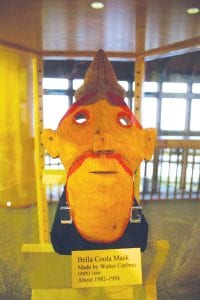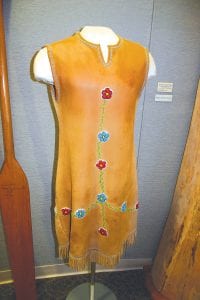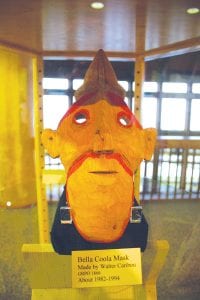For 34 years, a group of Grand Portage residents worked, talked, and laughed together while telling stories of their lives and their histories to anyone who wanted to listen. It was a piece of history in itself that is now being celebrated in an exhibit at the National Park Service’s Grand Portage National Monument.
“Grand Portage National Monument’s Cultural Demonstration Project was initiated in 1968 at the suggestion of monument staff to foster a setting where visitors could enhance their experience by interacting with Ojibwe elders to help personalize the Grand Portage story,” a storyboard explains.
Between 1968 and 2002, one to 10 Grand Portage residents a year worked at the monument creating everything from moccasins, hooked rugs, and dolls to wooden paddles, beadwork jewelry, and birchbark canoes.
Some worked inside the great hall of the fur trading depot. Others worked inside the log Crawford Cabin, the old ranger station, or a birchbark wigwam. They were hired as entry-level government employees but provided their own supplies and kept the profits from the sale of their work.

Middle: This beadwork design celebrating the bicentennial of the U.S. Constitution was created in 1987 by Ellen Olson and Bertha LaPlante.
The storyboards go on to say, “The elders of the community were always willing to share their time, knowledge, and talents to keep the history of Grand Portage alive, as they recognized that the stories, skills, and techniques they demonstrated were not only of the present but also of generations past.”
North American Indians once made beads out of copper and seashells. When the fur traders started coming through northeastern Minnesota, the Indian people started trading skins for glass beads which, along with dyed porcupine quills and moose hair embroidery, they used to adorn their clothing and jewelry. They traded various sizes of beads: barrel-size, pony-size, and seed-size. White became the most popular color.
Prior to 1800, designs were mainly geometrical, but curved patterns and floral motifs developed after that.
Ojibwe crafts were valued by the Europeans as exotic. After the fur trading days, the Grand Portage Ojibwe sold their work to passengers on ships.
“When the National Monument was established in 1958,” an exhibit storyboard states, “Grand Portage residents and their leaders held firm that one role of the monument was to stimulate the ‘manufacture and sale’ of Ojibwe handcraft.” Their tradition was to make beautiful utilitarian objects. In the 1960s an Arts and Crafts Guild was formed in Grand Portage to preserve art forms developed by Ojibwe people of the western Great Lakes.
Seventeen artisans participated in the program through the years, chit-chatting and telling jokes to each other in Ojibwe while they worked.
The exhibit, headed by Museum Technician Steve Veit, was put together by four Park Service employees with a lot of help from volunteers and in consultation with other employees. Many of the items on exhibit are on loan from people outside Grand Portage. It is an evolving exhibit, and more handcraft as well as photos are welcome. The exhibit is expected to be in place for about two years.
Artisans who were part of the
cultural demonstration project
at Grand Portage National
Monument from 1968 to 2002:
Sharon Vogel
Rose Porter
Dora Kasames
Martha Bushman
Sophie Crawford
Jennie Hietala
Emma Gagnon
Margaret Kozlowski
Elizabeth Thibault
John Flatte
Walter Caribou
Mary Dahl
Cecelia Hendrickson
Rachel Hunter
Bertha LaPlante
Eleanor Olson
Ellen Olson
(Only artisan still living.)




Loading Comments